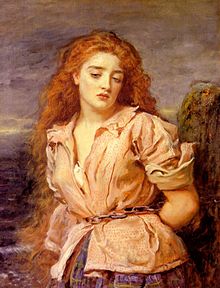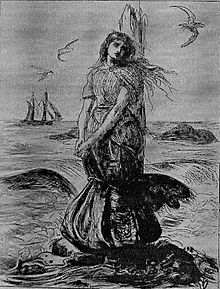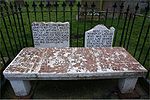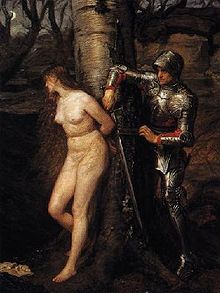- Margaret Wilson (Scottish martyr)
-
 The Wigtown Martyrs Monument in the Old Town Cemetery, Stirling, depicts Margaret Wilson reading the Bible with her young sister Agnes, watched over by a despairing guardian angel.
The Wigtown Martyrs Monument in the Old Town Cemetery, Stirling, depicts Margaret Wilson reading the Bible with her young sister Agnes, watched over by a despairing guardian angel.
Margaret Wilson was a young Scottish Covenanter, from Wigtown, Galloway in Scotland executed by drowning for refusing to swear an oath declaring the King as head of the church. She died on May 11, in 1685. Her death became part of the martyrology of Presbyterian churches, and she was commemorated as the most famous of the Wigtown Martyrs.
Contents
Martyrdom
The Covenanter movement to maintain the reforms of the Scottish Reformation came to the fore with signing of the National Covenant of 1638 in opposition to royal control of the church, promoting Presbyterianism as a form of church government instead of an Episcopal polity governed by bishops appointed by the Crown. The dispute led to the Wars of the Three Kingdoms and the overthrow of the monarchy. With the Restoration of the monarchy in 1660 the Covenants were declared treasonable and Episcopacy was restored. Particularly in the south-west of Scotland, ministers refused to submit. Barred from their churches, they held open air field assemblies called conventicles which the authorities suppressed using military force.
Margaret Wilson had been born at Glenvernoch, a farm near Newton Stewart in Wigtownshire. Her parents were dutiful Episcopalians, but her older brothers were among the Covenanters. By 1684 they were hiding from the authorities in the hills, and increasingly draconian action had ended the large conventicles. There were still small gatherings held indoors, but now failure to take a test of allegiance to the king, which required renouncing the Covenant, met with the death penalty, as did even attending a conventicle or harbouring Covenanters. Despite the risks, she began attending conventicles together with her younger brother Thomas, possibly beginning when there was an opportunity at a local conventicle to see the charismatic James Renwick who had newly become leader of the more extreme Covenanters known as the Cameronians. On occasion they also took along their young sister Agnes.[1]
In February 1685 the sixteen year old Thomas Wilson left to join other Covenanters in the hills. The girls went on a secret visit to Wigtown to visit friends, including an elderly widow Margaret McLachlan (there are various spellings of her second name). The young sisters Margaret and Agnes were taken prisoner, possibly after declining to drink the King's health, and put into the "thieves' hole". They refused to take the Abjuration Oath renouncing the Covenant. On the following Sunday Margaret McLachlan was arrested, and also put into the "thieves' hole" with the Wilson girls, along with a servant woman. Taken before the assizes of the Government Commissioners for Wigtownshire, the servant was found partially guilty and given a sentence of flogging and pillorying on three successive days. The other three were found guilty on all charges, and sentenced to be "tied to palisades fixed in the sand, within the floodmark of the sea, and there to stand till the flood o'erflowed them". The father of the girls, Gilbert Wilson, went to Edinburgh and made a plea to the Privy Council of Scotland for clemency for all three, presenting a petition which claimed that Margaret McLachlan had recanted. Agnes was granted freedom on a bond of 100 Pounds Scots, and reprieves were written out for the two Margarets with a date of 30 April 1685. There have been claims that the two women recanted the Covenant and were not executed, but Kirk Session records written out twenty years after the events provide detailed accounts supported by witness statements.[1][2]
Margaret Wilson and Margaret McLachlan, were condemned to death by drowning and were chained to stakes on the Solway Firth. Although at the last moment, choking on the salt water, Margaret Wilson was allowed to offer a prayer for the King, this was not good enough for her accusers, and she was forcibly thrust beneath the waves. It is said that, as the tide rose, she defiantly quoted from the psalms and the epistles and sang. After her drowning, witnesses described how her hair floated around her head like a halo in the clear water.[citation needed]
About 18 at the time of her death, Margaret Wilson was buried, together with her friend Margaret McLauchlan, in the churchyard of Wigtown.
Martyrology
The story of the Wigtown Martyrs was among those collected by Robert Wodrow and published in his History of the Sufferings of the Church of Scotland from the Restoration to the Revolution.[2] The Church of Scotland synod had decided in 1708 to collect accounts of persecution under the Stuart monarchs, and persuaded Wodrow to take on the research. The account was published in 1721, and had a considerable effect on public perception despite it being attacked by royalists and supporters of the Scottish Episcopal Church.[3]
Millais painting
 Painting of Wilson, The Martyr of Solway, by John Everett Millais, 1871.
Painting of Wilson, The Martyr of Solway, by John Everett Millais, 1871.
The death of Margaret Wilson was depicted in 1862 by the Pre-Raphaelite artist John Everett Millais in an illustration (shown above) for the magazine Once A Week. The magazine also reproduced the verses describing her death which are inscribed on her grave in Wigtown.
Some years later Millais revisited the subject in his painting The Martyr of Solway (1871) (shown at the left), which hangs in the Walker Gallery in Liverpool. Although the painting today shows Margaret wearing an open-neck blouse, when conservators x-rayed the piece, they found that the figure had once been a nude looking sharply to the right.[4] In fact the head and torso had originally formed part of Millais' 1870 painting The Knight Errant, which portrayed a naked rape victim tied to a tree. A medieval knight is depicted cutting her free, having killed her attacker. The painting received negative reviews, leading Millais to cut away the head and torso section and add a fresh piece of canvas to paint it anew, with the woman's head turned distinctly away to the left. The original figure section was added to a new canvas for the 1871 Martyr painting and was repainted with chains and the more modest blouse.[5]
Fictional treatment
The author Elizabeth Mackintosh (under the pen name Josephine Tey) in her novel 'The Daughter of Time' (originally published 1951) claimed that the two women were reprieved on their own petition by the Scottish Privy Council and that the reprieve is still in the Privy Council register "to this day". She further claims that "the original collector of the material, canvassing the Wigtown district only forty years after the supposed martyrdom and at the height of the Presbyterian triumph, complains that "many deny that this happened"; and couldn't find any eyewitnesses at all".[6]
See also
- Barbara Gilmour - fellow Scottish Covenanter.
References
- ^ a b Elizabeth Robertson (14 June 1997). "Sacrificed to the cruel flood". The Herald. http://www.heraldscotland.com/sport/spl/aberdeen/sacrificed-to-the-cruel-flood-1.393807. Retrieved 2009-12-21.
- ^ a b Robert Wodrow; Robert Burns (1836). The History of the Sufferings of the Church of Scotland from the Restoration to the Revolution. Glasgow: Blackie and Son Limited. pp. 246–249. http://books.google.co.uk/books?id=UWYNAAAAYAAJ&pg=PA247&dq=%22Margaret+Wilson%22+Robert+Wodrow+Robert+Burns+%22The+History+of+the+Sufferings+of+the+Church+of+Scotland+from+the+Restoration+to+the+Revolution%22&ei=BC5fS8b5LY30ygTA94WmBA&cd=1#v=onepage&q=&f=false. Retrieved 2009-12-21.
- ^ A. M. Starkey (1974). [ttp://www.jstor.org/stable/3164924 "Robert Wodrow and the History of the Sufferings of the Church of Scotland"]. 2nd Edition. Church History, Vol. 43, No. 4. pp. 488–498. ttp://www.jstor.org/stable/3164924. Retrieved 2009-12-21.
- ^ Liverpool Museums, The Martyr of Solway
- ^ Tate Gallery, The Knight Errant
- ^ Tey, J. (2002), The Daughter of Time, Arrow Books Ltd, ISBN 0-09943-096-7
External links
Categories:- 1680s deaths
- Covenanters
- People from Dumfries and Galloway
- Executed Scottish women
- People executed by drowning
Wikimedia Foundation. 2010.



